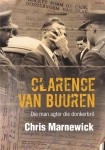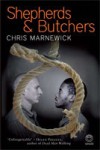News From South Africa by Michael Sears
This month we have a guest article by Chris Marnewick, who has just completed a small tour of southern hemisphere book conferences. Chris is a retired South African advocate – barrister – who now lives in Auckland. His debut novel SHEPHERDS & BUTCHERS won the Johannesburg University Prize and the K Sello Duiker Prize of the South African Literary Awards and is due to be turned into a feature film this year. Chris’ later novels – THE SOLDIER WHO SAID NO and A SAILOR’S HONOUR feature an expat SA soldier turned policeman who lives in Auckland but returns to South Africa every second year or so to settle old scores and to solve crime. Hopefully Chris will be back over here more frequently than that! Here’s his news from South Africa (and Auckland):
I recently did a round of literary festivals. I went to the University of Stellenbosch’s Woordfees – March 5 to 10 – and the University of Kwazulu-Natal’s Time of the Writer – March 19 to 24 in South Africa and then returned to Auckland, New Zealand, for its Readers & Writers Festival – May 9 to 13. My career as a writer had started at the Auckland Readers & Writers Festival in 2003. Jeffery Deaver and Jonathan Frantzen were the celebrity authors at that festival. My notes of the Deaver’s session list his comments and advice as follows:
- I try very hard to tell a story.
- I took my philosophy of writing from another writer, Mickey Spillane, who said that people don’t read books to get to the middle. They read to get to the end, so you have to drag them along to the ending. (I have a true Mickey Spillane story of my own later in this newsletter.)
- Where do I get my ideas? I buy them from a farmer in Pennsylvania!
- I rely heavily on structure. I spend 6 months on structure and first write an outline of 150 to 160 pages.
- Pace is absolutely vital.
- Then choreograph the ending. Bring all of the subplots and characters to their natural ending.
- Then write the prose and rewrite, editing sentence by sentence, eliminating tautology, excess words, the passive case and errors.
 I left that session to write my own book. It took 5 years before SHEPHERDS & BUTCHERS (Umuzi Random House 2008) was published. In SHEPHERDS & BUTCHERS I used the medium of a fictitious criminal trial to tell the truth about the manner in which capital punishment was administered during the apartheid years.
I left that session to write my own book. It took 5 years before SHEPHERDS & BUTCHERS (Umuzi Random House 2008) was published. In SHEPHERDS & BUTCHERS I used the medium of a fictitious criminal trial to tell the truth about the manner in which capital punishment was administered during the apartheid years.
It seems to me that, in South Africa at least, crime writing based on true crime has become very popular. The star of Woordfees was undoubtedly Hanlie Retief, an investigative journalist. Her BYLEVELD: DOSSIER OF A SERIAL SLEUTH tells the story of Brigadier Piet Byleveld, a hardened policeman once attached to the notorious Brixton Murder & Robbery unit in Johannesburg. Byleveld’s forte was – he is now in retirement – bringing serial killers to trial. According to Retief, Byleveld had a 100% success record in closing his dockets – the dossiers of the title – to arrest and conviction, and that by pure detective means. None of the tactics of the old Brixton Murder & Robbery for this policeman – at least one of the old guard, a Captain la Grange, ended up on Death Row for the murder of a drug dealer. Byleveld used guile and a good grasp of psychology to close his cases.
Back to the book: The publisher’s whole print-run of 27 000 was sold out in two weeks and sales have by now passed the 100 000 mark, when a bestseller in South Africa usually sells about 5 000. When I met the author in Stellenbosch, there was talk of film rights and a television series. The hall where Retief and Byleveld discussed the book was filled to capacity.
Non-fiction crime writing has received a good shot in the arm with the success of BYLEVELD. The success of Mandy Wiener’s KILLING KEBBLE (discussed in May’s newsletter) can only add to the impetus. She tells the story of the killing of Brett Kebble, a crook of note, who arranged his own killing after taking out a very large insurance policy on his life. We have had a case like this before. In 1963 or thereabouts Baron Dieter von Schauroth paid a young man, Marthinus Rossouw, to kill him. Rossouw was hanged for that and Von Schauroth’s insurers successfully repudiated the policies the latter had taken out on his own life. (It should come as no surprise to the reader that someone then wrote a book about the case.)
My own non-fiction book, CLARENCE VAN BUUREN: DIE MAN AGTER DIE DONKERBRIL, (The man behind the mask) was released during Woordfees. It tells the story of Clarence van Buuren, who was hanged in 1957 for the murder of Joy Aken, an 18-year old secretary. The case has intrigued me from my early childhood when I first read about it in the newspapers. There are so many unanswered questions. Was Van Buuren really guilty? He never confessed. Was he responsible for the sexual disfigurement of the body? His lawyer blamed wild animals. And how did a psychic manage to find the body when the police had been unsuccessful? Yes, indeed. A psychic found the body first.
Hanlie Retief was the star of the show at Woordfees and there is not much more I can report about that event.
The next event was an animal of a different character altogether. Time of the Writer in Durban was a delightful experience for me. I met some wonderful foreign writers; each in his or her own way had a connection with Africa. I played the shepherd when a bunch of guys wanted to find something to eat late one night and took them to the casino near our hotel. We tucked into chicken and corn while the two Jamaicans – Kwame Dawes and Colin Channer – entertained us with their stories and egged each other on. My namesake Chris Abani could write about true crime too, if he were so inclined. He had started writing at age 16 in Nigeria, was locked up and suffered political persecution for it.
Not that we don’t have our own. Ronnie Kasrils is a crime writer’s dream. Here is a man who has actually done the crime. He sabotaged, amongst other things, some electricity transmission pylons and was hunted by the police for that. He could have got the death penalty, had he been caught. Actually, now that I think about it: he would have got the death penalty. The apartheid police and courts were not playing around in those days. Ronnie’s book, THE UNLIKELY SECRET AGENT, is a moving tribute to his late wife Eleanor, who was a co-conspirator in his fight against the apartheid regime. The book reads like a thriller, but it is based on true crime. And Kasrils is great company at the dinner table.
I shared a platform with Jassie Mackenzie, one of the queens of SA crime fiction. Her Jade de Jongh character is so, well, so South African; Jade is a woman who knows how to handle a gun.
 After all the excitement of the two South African events, the Auckland Readers & Writers Festival was a bit subdued and far more serious in its pursuit of literary art as opposed to entertainment of the casual reader. Crime writing nevertheless featured in various sessions, including The Future of the Novel, A Mind for Murder, Creative Non-Fiction and most notably, An Hour with Peter James. James is a crime writer whose Inspector Roy Grace novels have sold many millions. Although not featured at the festival, the true crime story of the prosecution, conviction and ultimate acquittal – after he had served his sentence – of David Bain continues to attract sales for author Joe Karam and an ongoing debate in newspapers and magazines. Kiwis are fanatical readers of true crime, especially when the author suggests the man or woman behind bars has been wrongly convicted. The Weekend Herald of May 19, 2012 has a full page article on the murder of Susan Burdett in 1992. The report suggests that the wrong man – aged 16 years at the time – has been convicted of her murder. The conviction was based, so it appears, on his own contradictory confessions and on a jailhouse snitch’s evidence while another man – a serial rapist – was convicted of her rape but not her murder. There is a plot for a crime novel in the story.
After all the excitement of the two South African events, the Auckland Readers & Writers Festival was a bit subdued and far more serious in its pursuit of literary art as opposed to entertainment of the casual reader. Crime writing nevertheless featured in various sessions, including The Future of the Novel, A Mind for Murder, Creative Non-Fiction and most notably, An Hour with Peter James. James is a crime writer whose Inspector Roy Grace novels have sold many millions. Although not featured at the festival, the true crime story of the prosecution, conviction and ultimate acquittal – after he had served his sentence – of David Bain continues to attract sales for author Joe Karam and an ongoing debate in newspapers and magazines. Kiwis are fanatical readers of true crime, especially when the author suggests the man or woman behind bars has been wrongly convicted. The Weekend Herald of May 19, 2012 has a full page article on the murder of Susan Burdett in 1992. The report suggests that the wrong man – aged 16 years at the time – has been convicted of her murder. The conviction was based, so it appears, on his own contradictory confessions and on a jailhouse snitch’s evidence while another man – a serial rapist – was convicted of her rape but not her murder. There is a plot for a crime novel in the story.
I promised a true Mickey Spillane story. In late 1956 when Clarence van Buuren was being held in prison pending his trial, he tried in various ways to establish an alibi. One of them was to pin the blame on a specific person, one Morris who was in custody on unrelated charges. Morris, Van Buuren told the police, had made a full confession to the murder of Joy Aken and had done so in the prison yard. The investigating officer was obliged to take statements from the other men who had overheard the so-called confession. The man to whom they attributed the confession was Morris, whom they knew as Mike Hammer, the name of the private detective hero of Mickey Spillane’s novels I THE JURY (1947), MY GUN IS QUICK (1950), VENGENCE IS MINE! (1950), THE BIG KILL (1951) and KISS ME DEADLY (1951). When Morris was questioned about the incident he laughed and said, ‘It was a hell of a joke!’
True crime is no joke, of course, but it appears to me that it does provide authors with ideas. We don’t have to buy our ideas from a farmer in Pennsylvania!
- International Thrills: Fiona Snyckers - April 25, 2024
- International Thrills: Femi Kayode - March 29, 2024
- International Thrills: Shubnum Khan - February 22, 2024

